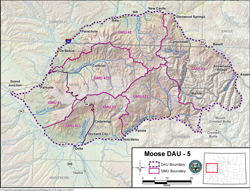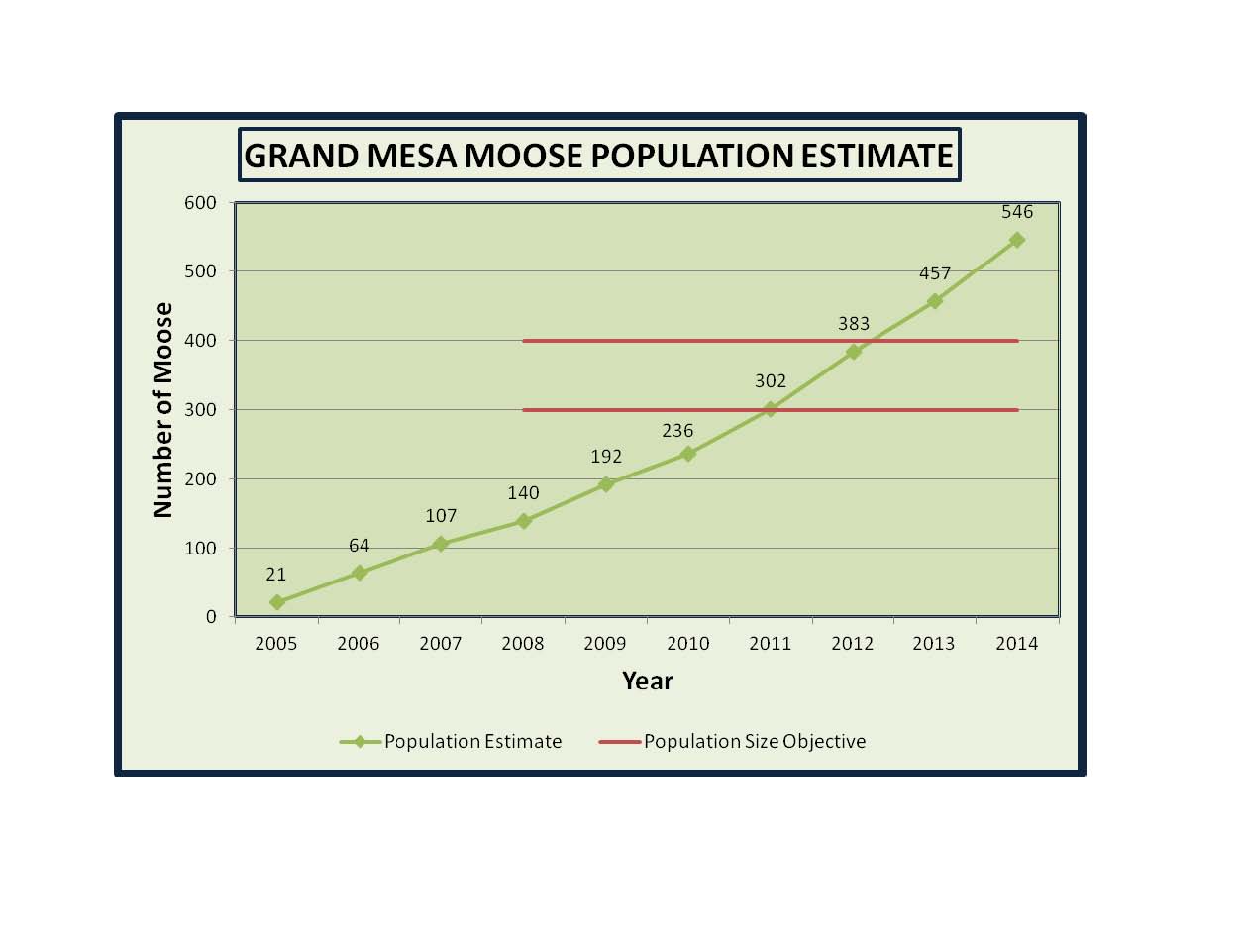Project Update
In the spring of 2001, CPW was approached by interested Grand Valley citizens with a proposal to establish a moose population in the Grand Mesa area east of Grand Junction, Colorado. Both internal and external deliberations led to a decision to investigate the feasibility of such a project. The successful establishment of viable moose populations in other locations in Colorado provided incentive to explore the possibilities of such a project.
The feedback from the initial discussions indicated that an assessment of the habitat would be appropriate and a study was completed to determine if there was sufficient forage suitable to support a viable, self-sustaining moose population on Grand Mesa.
Among the concerns raised at public meetings was whether moose would compete with domestic livestock on grazing land, and whether the large animals would have a negative impact on other wildlife species and the local ecosystem. A vegetative assessment, completed in spring 2004, indicated that the Grand Mesa could support 278 – 464 moose during times of limited forage.
Following the public input and habitat analysis, CPW decided to proceed with reintroducing moose to
the Grand Mesa. Between 2005 and 2007, 91 moose were translocated to the Grand Mesa to establish a self-sustaining moose herd on the Grand Mesa. All moose were fitted with a unique numbered ear tag and, a radio transmitter. The moose were released in three main areas: the Skyway area, and the Muddy Creek and Buzzard Creek drainages.
A herd management, or data analysis unit (DAU), plan was developed in 2008 and approved by the Wildlife Commission in 2009. DAU plans are developed through a public process and are used to guide the management of big game populations across the state. This plan identified a post hunt population size objective of 300 – 400 moose, a composition objective of 50 – 60 bulls: 100 cows and a 5 year average antler spread of 35 inches or greater on harvested bulls.

These objectives will guide moose management on the Grand Mesa and in the Crystal River drainage for the next 10 years.
Of the 91 moose that were transplanted to the Grand Mesa, ten cows and one bull still have functional collars and are still located regularly within the transplant area.
Annual survival has been very high among collared moose, averaging above 90% for both adult bulls and adult cows. A visual observation is made annually of each adult cow to document reproduction. Since 2008, calf: cow ratios have averaged 75.2 calves: 100 cows and twinning rates have been high, with twins born in an average of 21% of all births.

Since release, forty-two of the telemetered moose have died. Seven mortalities were directly related to capture. Seven collared animals (and at least two "un-collareduncollared animals) have been killed by vehicles. Three have died of factors associated with age. In sixteen instances, the cause of death was indeterminate. One cow died in a fall or avalanche, and another died while calving. Four bulls were legally harvested in 2009 and 2010. One calf was killed illegally by an elk hunter, and it is likely that one other cow was killed illegally as well. Two uncollared, unmarked moose have been killed illegally.
The moose have pioneered across the Grand Mesa and into the Crystal River Valley to the east. Moose have
been located in nearly all the available habitat types in the project area. On the Grand Mesa, moose are found most frequently Gambel oak-dominated woodlands, followed by aspen, then conifer forests, and mixed aspen-conifer stands. Only 3% of locations since 2005 have been in willow or riparian areas.
Approximately 60% of the locations are between 8,000 and 9,000 feet in elevation. Seasonal migration is minimal, although there is slightly more use of lands above 9,000 feet in summer and fall, and slightly more use of lands below 7,500 feet in spring and fall.
Antlered moose hunting began in 2009, when two licenses were issued. Four antlered licenses were issued each in 2010 and 2011. Six antlered licenses were issued in 2012. Success rates have been high; 100% in 2009 and 2011, and 75% in 2010. The average spread since 2009 has been 37.6”.
 The population is growing quickly and is estimated to be approximately 380 moose in fall 2012, which is within the objective population range. It is likely, based on documented reproduction and survival, that the population size could exceed the established objective by 2013.
The population is growing quickly and is estimated to be approximately 380 moose in fall 2012, which is within the objective population range. It is likely, based on documented reproduction and survival, that the population size could exceed the established objective by 2013.
Moose can be found throughout the Grand Mesa, but there are some likely spots for moose viewing along the road. Moose are frequently spotted from USFS Forest Road 265 between Collbran and McClure Pass, as well as along Highway 65 between Powderhorn and the Mesa-Delta County line. Vega State Park is another area to chance upon a moose. The shaded areas in the map below show good spots for moose viewing on the Grand Mesa.

